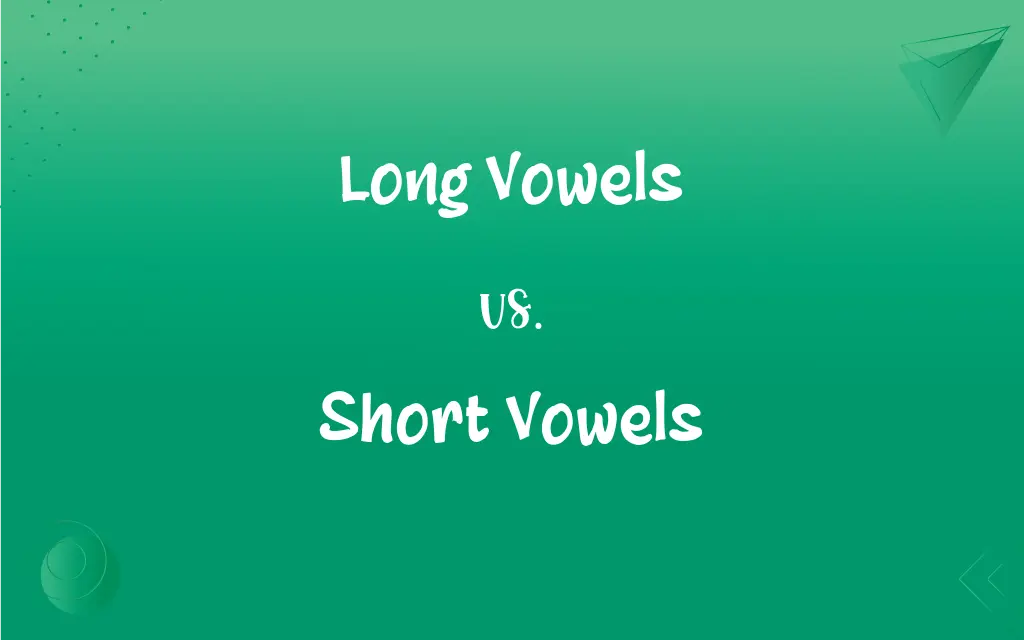Long Vowels vs. Short Vowels: What's the Difference?
Edited by Harlon Moss || By Janet White || Published on November 2, 2023
Long Vowels vs. Short Vowels: Long vowels sound like the names of the vowels (e.g., "a" in "cake"), while short vowels don't (e.g., "a" in "cat").

Key Differences
Long Vowels and Short Vowels are fundamental elements in phonetics, shaping the pronunciation of words in the English language. Long Vowels, as the name suggests, have an elongated sound that matches the vowel's name. For instance, the “a” in “cake” is pronounced like the letter “A”. In contrast, Short Vowels have a quicker, distinct sound that doesn't resemble the vowel's name, like the “a” in “cat”.
Understanding the distinction between Long Vowels and Short Vowels is crucial for learners of English. Long Vowels often appear in words where the vowel is followed by a single consonant and a silent “e”, as in “note”. On the other hand, Short Vowels usually manifest in words where the vowel is surrounded by consonants, as seen in the word “not”.
Both Long Vowels and Short Vowels have specific rules and patterns in spelling and pronunciation. Long Vowels can be influenced by the presence of certain letters; for instance, the “ai” in “rain” makes an elongated “a” sound. In comparison, Short Vowels tend to be more straightforward, remaining consistent in various words like “bat,” “cat,” and “hat”.
Phonetic symbols are also employed to represent Long Vowels and Short Vowels. Long Vowels have specific symbols in phonetic transcription to indicate their extended sound. Short Vowels, meanwhile, are represented by symbols that differ from the regular alphabet letters to show their unique sounds.
It's worth noting that both Long Vowels and Short Vowels contribute to the rhythm and intonation of spoken English. Words with Long Vowels might be stressed more in a sentence, providing emphasis, while words with Short Vowels might be spoken quicker, maintaining the sentence's pace.
ADVERTISEMENT
Comparison Chart
Sound Duration
Extended, like the vowel's name
Quick and distinct
Typical Spelling Pattern
Often followed by a single consonant and a silent “e”
Usually surrounded by consonants
Example Word
“note”
“not”
Phonetic Representation
Specific symbols for elongated sound
Distinct symbols different from regular letters
Influence in Sentences
Can add stress or emphasis
Spoken quickly, maintaining sentence pace
ADVERTISEMENT
Long Vowels and Short Vowels Definitions
Long Vowels
Vowels that sound like their respective names.
The “i” in “like” is a Long Vowel.
Short Vowels
Vowels that typically appear in consistent patterns.
The “o” in “pot” is a Short Vowel.
Long Vowels
Vowels that contribute to the rhythm and emphasis in speech.
The word “beet” stresses the Long Vowel sound.
Short Vowels
Vowels that do not sound like their names.
The “a” in “cat” is a Short Vowel.
Long Vowels
Vowels that often appear with specific spelling patterns.
The “o” in “bone” is a Long Vowel due to the silent “e”.
Short Vowels
Vowels that are pronounced quickly in speech.
The word “hat” swiftly moves to the next word due to its Short Vowel.
Long Vowels
Vowels that have an elongated sound.
The word “seat” contains a Long Vowel.
Short Vowels
Vowels that maintain the pace of a sentence.
The word “bat” has a Short Vowel sound, helping maintain speech tempo.
Long Vowels
Vowels with a prolonged phonetic duration.
The word “tree” has a Long Vowel sound.
Short Vowels
Vowels with a brief and distinct sound.
The word “bit” contains a Short Vowel.
FAQs
What about spelling patterns for Short Vowels?
Short Vowels usually appear in words where the vowel is surrounded by consonants, such as “not”.
Do Long Vowels and Short Vowels have phonetic symbols?
Yes, both have specific phonetic symbols to represent their sounds.
What are Long Vowels?
Long Vowels sound like the names of the vowels, such as the “a” in “cake”.
Why is understanding Long Vowels and Short Vowels important?
Distinguishing them aids in pronunciation, reading, and comprehension of English.
Are there spelling patterns for Long Vowels?
Yes, Long Vowels often appear in words with a silent “e”, like “note”.
How do Short Vowels sound?
Short Vowels have a distinct sound that doesn’t resemble the vowel's name, like the “a” in “cat”.
Do Long Vowels hold emphasis in sentences?
Often, Long Vowels can be stressed, giving emphasis to words.
Can a vowel letter represent both Long Vowels and Short Vowels sounds?
Absolutely, context and spelling patterns determine the sound.
Are there exceptions to the spelling rules for Long Vowels?
Yes, English has numerous exceptions due to its diverse linguistic influences.
About Author
Written by
Janet WhiteJanet White has been an esteemed writer and blogger for Difference Wiki. Holding a Master's degree in Science and Medical Journalism from the prestigious Boston University, she has consistently demonstrated her expertise and passion for her field. When she's not immersed in her work, Janet relishes her time exercising, delving into a good book, and cherishing moments with friends and family.
Edited by
Harlon MossHarlon is a seasoned quality moderator and accomplished content writer for Difference Wiki. An alumnus of the prestigious University of California, he earned his degree in Computer Science. Leveraging his academic background, Harlon brings a meticulous and informed perspective to his work, ensuring content accuracy and excellence.








































































